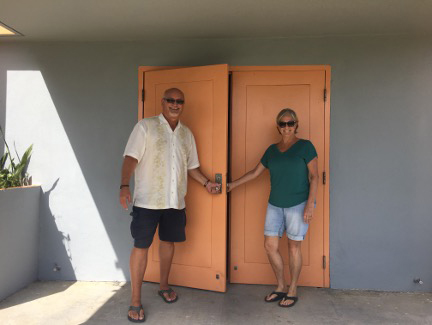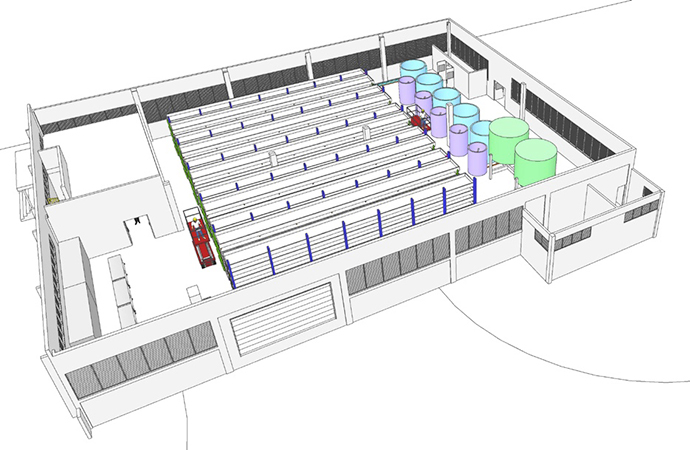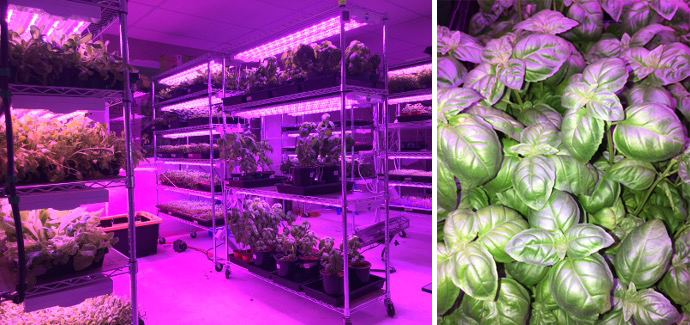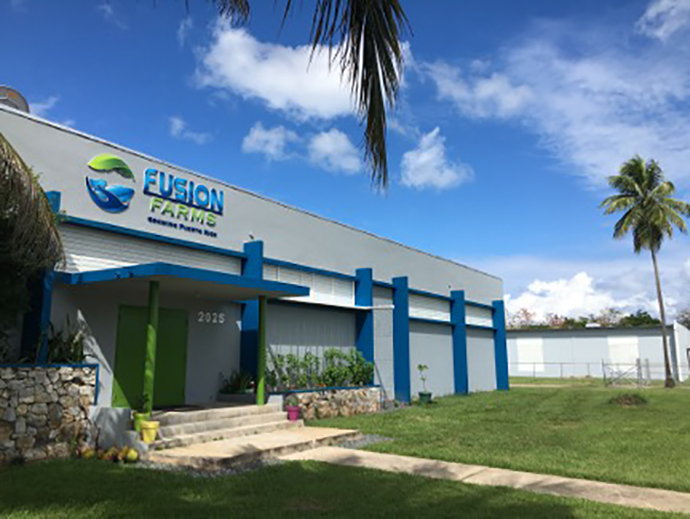As a pandemic brings the world economy to its knees, it’s just the latest existential threat in Puerto Rico, an island all too frequently visited by hurricanes and, this year, earthquakes that struck in December and again early this month.
For this island of 3.2 million, where the population is finally inching upward again after a decade of population loss, it’s just another opportunity to demonstrate resiliency and long-term sustainability. “The point of our work is business development with quality jobs and quality investment over time,” says Rodrick Miller, the CEO of Invest Puerto Rico, whose past positions in Detroit and New Orleans have taught him a thing or two about bouncing back up from a knockdown.

Enter Fusion Farms, an aquaponics company aiming to do a whole lot more than farm fish.
“The opportunity to help a location achieve food sovereignty became a motivational underpinning of our site selection” says Fusion Farms co-founder Kendell Lang. That criterion ironically drove he and his wife Lisa Jander to a U.S. territory that’s been seeking sovereignty as a state for a long time. “Our primary location selection criteria were based on where we could make the maximum impact.”
After years of warm-weather global tourism with a purpose, the couple landed in an Opportunity Zone in Mayagüez (more than 95% of Puerto Rico is an OZ) with their first Closed Environment Aquaponics facility to grow tilapia in a low-slung concrete warehouse that was hit hard by Maria but stood strong. The opportunity to help the island’s citizens achieve food security was immediate. So was the opportunity to be part of a global aquaculture economy that has grown to represent 47% of the 171 million metric tons of global fish production in 2016, and US$232 billion of the world’s overall fisheries and aquaculture value of $362 billion.
This week, the team is bringing the first fish into the building as the complete aquaponics system is installed. In April, Lang responded to my questions by email.
Describe how you chose to land in Mayagüez with your company.
Kendell Lang: Our primary location selection criteria was based on where we could make the maximum an IMPACT. Although there are a variety of selection criteria that we also evaluated (sunny weather, ease of travel, tax incentives, cost of living, language, etc.), the biggest concern was where could we have the best opportunity to implement our desire to build and own a sustainable organic farm that would make a difference. My wife Lisa and I spent at least a month out of each of the last 10 years traveling to prospective locations and spending time exploring and getting to know the locations we were considering. We share an insatiable desire to make a contribution. We spent a month in Chile, we spent a month in Costa Rica, we spent a month in Southern Italy, all with the objective to evaluate buying and building out the farm of our dreams.
As we explored these locations, the vision of making an impact evolved into helping create a solution for the food insecurity in places which were literal and virtual food deserts … Costa Rica and Chile have achieved food sovereignty, so they can grow all the food they need to support their population without any need to import food. Although New Zealand is an island, it too has achieved food sovereignty and doesn’t require imports to survive. Puerto Rico is a net importing island with over 90% of the food consumed on the island coming from somewhere else. We started coming to Puerto Rico in 2016 and ended up in escrow to buy a farm in the fall of 2017. Because we could not get an easement on to provide clear access to the farm, we canceled escrow. That was 10 days before Hurricane Maria made its mark on Puerto Rico.

Hurricane Maria, which made landfall on September 20, 2017, was the worst natural disaster in recorded history to affect Puerto Rico and was also the deadliest Atlantic hurricane since Jeanne in 2004. Add to the tragedy a long history of government corruption, failing infrastructure and lack of aid, even though Puerto Rico is a U.S. territory, and you’ve got an island on its knees, barely capable of feeding its own residents, all American citizens.
But how do you protect a farm, even an indoor one, from a category five hurricane with wind speeds of 175 mph? The answer lies in the abandoned concrete warehouses that scatter the island of Puerto Rico. Belonging to the Puerto Rico Industrial Development Company (PRIDCO), these buildings were once thriving places of industry, predominantly pharmaceutical, but were steadily abandoned as debt, an unstable power grid, the rapid consolidation of manufacturing facilities and a changing tax structure drove business to the ground.
Fusion Farms is now an 11,500-sq.-ft., hurricane-protected, climate-controlled, indoor vertical aquaponics facility powered by renewable energy. Leveraging the natural relationship between plants and fish, Fusion Farms can produce a regular, reliable cornucopia of fresh leafy greens, herbs, vegetables, fruits and fish for local Puerto Rican communities. Moreover, with an indoor vertical rack system, it can grow nine to 12 times the annual yield of traditional farming with 10% of the water.

Out all the locations we scouted across the island, we chose Mayagüez because of the building’s close proximity to the University of Puerto Rico’s Mayaguez Campus, with whom we’ve developed a Cooperative Research and Development Agreement (CRADA). Easy access to the university, as well as convenience for student interns to visit our facility, played a role in our location decision. It also helped that we could live in Rincon, a well-known surfing haven that would address one of my other personal passions.
I first learned about the promise of aquaculture while writing a story called “Growing Protein” five years ago about VeroBlue’s barramundi farming concept, beginning in Iowa. That story has not ended well, with bankruptcy and lawsuits. What are the distinguishing characteristics that you think make Fusion Farms’ model will succeed?
Lang: There are a variety of success stories around the world, as well as a number of unfortunate failures as you have identified. I did as much research as possible on both the successes and the failures, and the conclusion I reached about the failures was that it wasn’t because the concept or technologies of aquaculture, hydroponics or aquaponics failed. It usually had to do with lack of capital or people problems (inexperienced people not knowing how to manage a complex ecosystem, like a Wall Street banker with no ag experience deciding to build out a massive indoor vertical farm).
Our focus has been to adopt and implement well-proven technologies and to not reinvent the wheel when it comes to the agricultural systems we are using. The single focal point of our solution in Puerto Rico was to address the one thing that wiped out 80% of the farms — Hurricane Maria. All of the other variables have been proven out around the world, so we’re not doing anything new with aquaponics or vertical farming. The primary adaptation we have made is to put these proven ag solutions into a hurricane-protected building so you can farm year-round without interruption due to any environmental — or as COVID-19 has also pointed out, any pandemic — event that interrupts the supply chain.

Another key part of what we believe will help us achieve our objectives is by surrounding ourselves with world-class leaders to make sure we don’t make simple errors along the way. For example, we have two faculty from the University of Mayagüez on our board. We have a 30-year aquaculture operator supplying fish to Puerto Rico as our "fish expert" also on our board. We have the head of the University of Arizona’s Ag Department on our board and we have an MOU with their Controlled Environment Ag team. We have hired local farmers to work for us, as well as retained leading subject matter experts from successful projects from as far away as Australia.
One of the keys to our success is the relationship with PRIDCO and the partnership we achieved. They have a large inventory of vacant facilities across the island, so when they realized that our proposal had a much greater potential to impact Puerto Rico than just one building, they approved an administrative ordinance to provide us with a variety of incentives. We were given a below-market lease rate, we were granted $250,000 in solar incentives, we qualified for no sales tax, we are located in a Zona Libre (Foreign Trade Zone), and we have a variety of employment training reimbursements and tax rate incentives, all of which are part of the combined incentives created by PRIDCO.
While aquaponics is clearly separate from biopharma and medical devices, are there ways in which the overall orientation and supply chain network of the island’s robust life sciences economy accrue to your benefit?
Lang: There are actually quite a number of similarities, especially when it comes to bio-security. Because we are growing in controlled environments, you can think of it essentially as “clean rooms" just like for pharmaceutical manufacturing. We need a “clean room” environment to prevent pests, insects, disease or any other challenge typically associated with outdoor growing. We have relied on a lot of the research and development done by indoor cannabis growers who have taken indoor growing to an extreme level of sophistication, so we are using a knowledge set created by thousands of operators for understanding temperature control, lighting spectrum, humidity control, nitrogen control, water temperature, air movement, dissolved oxygen percentage, nutrient mixtures, good bacteria management and a host of other factors.
With respect to the supply chain, we are different from the biopharma operators in that our current focus is on hyper-local food production. We are not yet exporting, as the net importing status of Puerto Rico means we have to generate more than $3.5 billion in local food production before we can become an exporting island. Part of the model in food security means that we need to supply all the food the residents of the island need without relying on any imports. We also favor hyper-local food sources because of the nutrient content, as we don’t want our food to experience "food miles" which depletes food of its natural nutrients.
Chef José Andrés has done some amazing cooking events for the island in order to raise awareness as well as literally feed people, and he operates his World Central Kitchen and “Plow to Plate” initiatives. Have you collaborated in any way?
Lang: While we are aware of the amazing work they’re doing at World Central Kitchen, we have not yet collaborated with them. We hope to be able to do that in the future, but not yet. The need is for hundreds of similar operators implementing solutions like this. So we applaud their efforts, and encourage as many folks as possible to join in some type of contribution to help solve food security for Puerto Rico.
How has your investor attraction effort gone thus far? Are there other, complementary operations to yours landing in Puerto Rico too? What are your next steps?
Lang: We have been blessed with over 170 investors in two different funding rounds which have helped us get where we are. We are now raising funds for our second and third locations in other parts of the island. There are numerous ag operators coming to the island, many of which are focused on the hemp legislation which was passed last November. We have been successful at getting our hemp license, so we will be building out dedicated facilities for the hemp side of our business in the not-too-distant future. We have been actively involved with InvestPR and PRIDCO to help share our story with prospective investors and operators interested in replicating our model.

